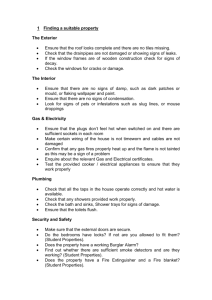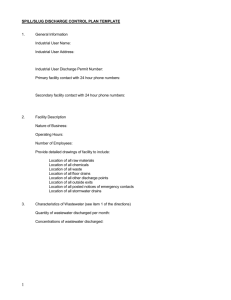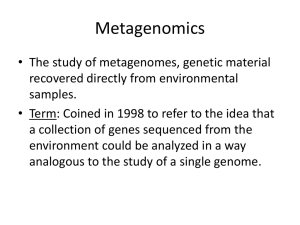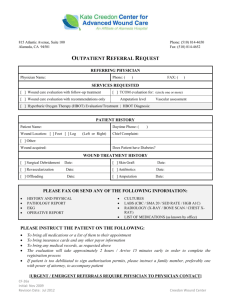An unusual hunting-related death due to a Brenneke
advertisement
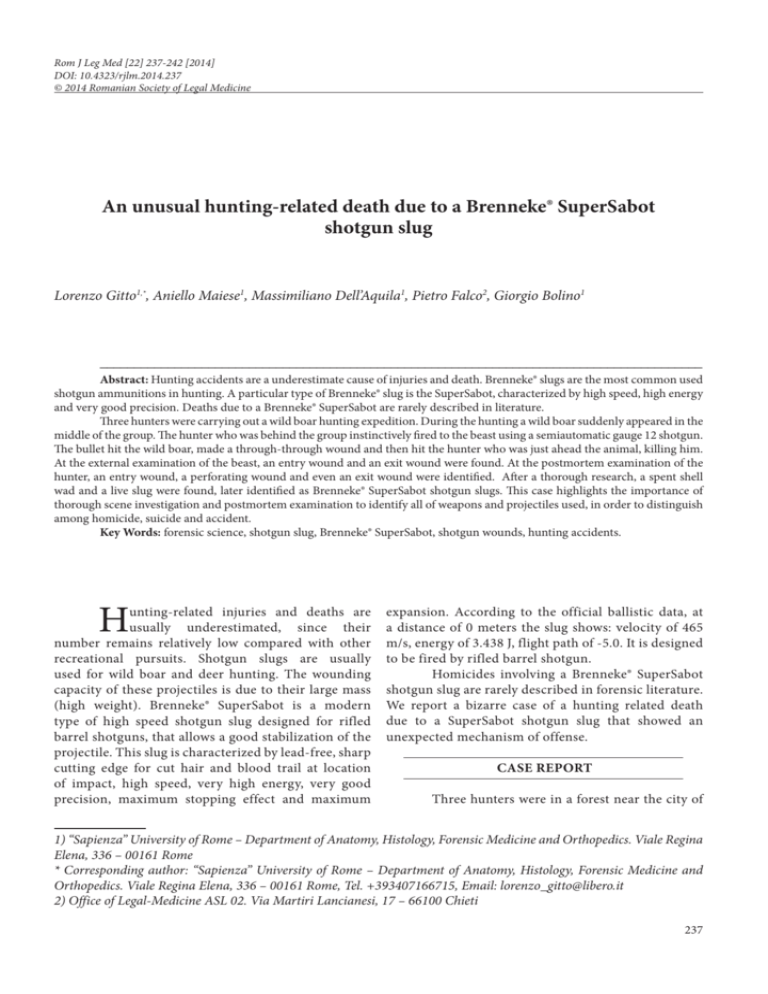
Rom J Leg Med [22] 237-242 [2014] DOI: 10.4323/rjlm.2014.237 © 2014 Romanian Society of Legal Medicine An unusual hunting-related death due to a Brenneke® SuperSabot shotgun slug Lorenzo Gitto1,*, Aniello Maiese1, Massimiliano Dell’Aquila1, Pietro Falco2, Giorgio Bolino1 _________________________________________________________________________________________ Abstract: Hunting accidents are a underestimate cause of injuries and death. Brenneke® slugs are the most common used shotgun ammunitions in hunting. A particular type of Brenneke® slug is the SuperSabot, characterized by high speed, high energy and very good precision. Deaths due to a Brenneke® SuperSabot are rarely described in literature. Three hunters were carrying out a wild boar hunting expedition. During the hunting a wild boar suddenly appeared in the middle of the group. The hunter who was behind the group instinctively fired to the beast using a semiautomatic gauge 12 shotgun. The bullet hit the wild boar, made a through-through wound and then hit the hunter who was just ahead the animal, killing him. At the external examination of the beast, an entry wound and an exit wound were found. At the postmortem examination of the hunter, an entry wound, a perforating wound and even an exit wound were identified. After a thorough research, a spent shell wad and a live slug were found, later identified as Brenneke® SuperSabot shotgun slugs. This case highlights the importance of thorough scene investigation and postmortem examination to identify all of weapons and projectiles used, in order to distinguish among homicide, suicide and accident. Key Words: forensic science, shotgun slug, Brenneke® SuperSabot, shotgun wounds, hunting accidents. H unting-related injuries and deaths are usually underestimated, since their number remains relatively low compared with other recreational pursuits. Shotgun slugs are usually used for wild boar and deer hunting. The wounding capacity of these projectiles is due to their large mass (high weight). Brenneke® SuperSabot is a modern type of high speed shotgun slug designed for rifled barrel shotguns, that allows a good stabilization of the projectile. This slug is characterized by lead-free, sharp cutting edge for cut hair and blood trail at location of impact, high speed, very high energy, very good precision, maximum stopping effect and maximum expansion. According to the official ballistic data, at a distance of 0 meters the slug shows: velocity of 465 m/s, energy of 3.438 J, flight path of -5.0. It is designed to be fired by rifled barrel shotgun. Homicides involving a Brenneke® SuperSabot shotgun slug are rarely described in forensic literature. We report a bizarre case of a hunting related death due to a SuperSabot shotgun slug that showed an unexpected mechanism of offense. Case Report Three hunters were in a forest near the city of 1) “Sapienza” University of Rome – Department of Anatomy, Histology, Forensic Medicine and Orthopedics. Viale Regina Elena, 336 – 00161 Rome * Corresponding author: “Sapienza” University of Rome – Department of Anatomy, Histology, Forensic Medicine and Orthopedics. Viale Regina Elena, 336 – 00161 Rome, Tel. +393407166715, Email: lorenzo_gitto@libero.it 2) Office of Legal-Medicine ASL 02. Via Martiri Lancianesi, 17 – 66100 Chieti 237 Gitto L. et alAn unusual hunting-related death due to a Brenneke® SuperSabot shotgun slug Figure 1. External examination of the wild boar. Overview of the entrance and the exit wound side. Figure 2. Entrance wound on the wild boar. Figure 3. Exit wound on the wild boar. 238 Rome, carrying out a wild boar hunting expedition. According to the deposition of the survived hunter, while they were walking inside the forest, a wild boar suddenly appeared in the middle of their group. The Hunter 1 who was located behind the group shot instinctively the wild boar that was in front of him, killing the animal. However, the projectile came out from the body of the animal and went to strike and kill the Hunter 2 who was located im-mediately in front of the boar. The Hunter 1 escaped into the forest and was found unresponsive two days later at a distance of about 1.3 km from the accident site. Near his body a semi-automatic shotgun model “Breda”, gauge 12, cylindrical chamber 50 cm in length, smooth bore barrel, without chokes was found, together with a live slug model “Brenneke® Super Sabot 12/70, 490 g. 63 diameter slug”. Near the wild boar’s body a spent wad was found. An external examination of the wild boar and full X-ray studies and postmortem examinations of Hunter 1 and Hunter 2 were performed. At the external examination of the beast (Fig. 1), on the upper third of the left foreleg a roundshaped wound was found, 2.5 cm in diameter, showing a concentric margin of contusion and abrasion surrounding the defect. The morphological features of the wound were compatible with a wound of entrance and with a long distance shot, although the thick fur of the beast could have led to misinterpretations (Fig. 2). On the right chest an irregularly-shaped wound was observed, 2.8 x 2.8 cm in size, showing marginal tears caused by the projectile pushing the skin outward. No burning, smoke or powder soiling were evident. The wound size was slightly bigger than the entrance wound. The morphological features were compatible with a wound of exit (Fig. 3). The wound course traveled from left to right and from backward to forward and upwards. X-ray scans were performed on both dead hunters before the autopsies. On Hunter 2, X-rays showed a fracture of the femoral diaphysis but no metallic fragments from the slug were displayed. On Hunter 1, no abnormal x-ray scans features were present. An autopsy of the Hunter 2 was performed later. On the posterolateral surface of the left thigh, 68 cm above the left heel, an irregularly oval-shaped wound was found, 2.8 x 2.9 cm in size, showing a margin of contusion from 12 pm to 2 pm and from 6 pm to 8 pm. A concentric ring of abrasion surrounded the defect. The morphological features of the wound were compatible with a wound of entrance produced by a bullet previously destabilized (Fig. 4). On the anteromedial surface of the left thigh, 69 cm above Romanian Journal of Legal Medicine Figure 4. Entrance wound on the hunter. Vol. XXII, No 4(2014) the left heel, there was an oval-shaped wound, 4.5 x 3 cm in size, with skin flaps pushed outward. The wound size was bigger than the entrance wound. The morphological features were compatible with a wound of exit (Fig. 5). The wound involved the skin and the soft tissues of the left thigh, the femoral diaphysis and the femoral artery, and finally exited on the anterior surface of the left thigh getting lost in the forest. The wound course traveled from left to right and upwards. Finally, a postmortem examination of Hunter 1 was performed. The main pathological finding was a widespread scar tissue on the myocardium together with severe atherosclerosis of all the coronary arteries. Microscopic findings showed the presence of a recent myocardial infarction. On the body, no signs of violence or other injuries were found. According to these features, the manner of death was pronounced as natural. Discussion Figure 5. Exit wound on the hunter. Figure 6. Brenneke® SuperSabot Shotgun Slug found on the crime scene. Shotgun injuries are severe, largely secondary to the size and mass, when compared with handgun injuries. While the entrance wounds produced by shotgun slugs can be comparable with other bullet entrances, the exit wounds may be absent in shotgun shells (“birdshot”) even in contact or close range shot, whereas they are frequently found in shotgun slugs injuries [1]. The wound of entrance from a shotgun slug is commonly circular in shape, with a diameter approximately that of the slug, and even with abraded edges [2]. The appearance of a shotgun exit wound is totally random, depending on the anatomical part injured and on the eventual addition of any bone or tissue fragments blown out in the discharge. Wounds of the limbs, neck and head may well be 'through-andthrough' with a twelve-bore shotgun and occasionally with the small 'four-ten' [3]. If the bullet gets fragmented inside the body, the exit wound usually results in a huge ragged aperture wound. The internal injuries produced by a shotgun slug are severe and massive. Shotgun-related injuries are commonly seen in hunting accidents. Hunting-related deaths may derive from suicide, homicide, and accident, and sometimes it is very hard to distinguish between them [4, 5]. According to the Italian Institute of Statistics (ISTAT), in 2012 hunters represented approximately 2% of the entire Italian population. In the past hunting season firearmrelated hunting deaths were 11, while not-lethal injuries were 75. Since many hunting-related accidents are not reported, their incidence is underestimated [6, 7]. Firearm-related hunting accidents amount to approximately 60% of all the hunting-related injuries 239 Gitto L. et alAn unusual hunting-related death due to a Brenneke® SuperSabot shotgun slug Figure 7. Digital reconstruction of the event. and may be due to several causes, such as: improper handling of the firearm, failure to alert the victim before firing, covering a companion during the hunt, ricocheting projectiles [8]. In most cases the fatal injury is localized to the chest and/or abdomen. However, in case of unintentional self-inflicted injuries, the majority of injuries was inflicted to the head [9]. Despite this, hunting-related injuries may not be related to the action of a firearm (e.g. falling from a hunting blind stand) [10, 11]. Hunters usually use single large slugs of various designs. A modern shotgun slug is a heavy lead or copper-covered lead projectile, with or without a plastic tip, that may have what appears to be rifling, but these are special cuts in the slug to let it deform when passing through a tight choke. The "slugs" are designed to be used in shotgun and are often used for hunting big game [12, 13]. Brenneke® slugs are among the most common used shotgun slugs, that have a lead head with 12 slanted guide ribs, and cardboard and felt wadding attached to the base by a screw [14]. Since the Brenneke slug is solid it will generally deform less on impact and provide Figure 8. Brenneke® SuperSabot ballistic data. Distance (m) 0 25 50 75 100 240 Velocity (m/s) 429 385 350 323 304 Energy (J) 2926 2356 1942 1661 1467 Flight path (cm) -5.0 +2.0 +4.9 +2.7 -5.2 deeper penetration. A particular type of Brenneke® ammunition is the SuperSabot, designed for use in a 12-gauge shotgun, fitted into a sabot to facilitate its use in the 12-gauge barrel. A sabot is a device used in a firearm to fire a projectile that is smaller than the bore diameter. The sabot is designed to separate from the projectile after exiting the muzzle, falling on the ground within 15 m from the shooter. The SuperSabot slug has a very good precision even in long distance, with a recommended distance of fire more than 80 meters. Although the supersabot slug is used primarily in rifled barrels in order to improve accuracy of fire, it can be fired in smooth-bore shotguns barrel shotgun. The high energy and the high penetration capacity of this bullet usually produce wounds similar, by gravity, to those produced by projectiles fired by high velocity rifles [15]. The ballistic data of the SuperSabot shotgun slug are shown in Table 1, and are based on the official data reported by Brenneke®. While cases of suicides and homicides involving an original Brenneke® shotgun slug have been reported in literature [16, 17], fatal cases involving a Brenneke® SuperSabot shotgun slug are rarely described. A review of forensic literature yielded only one previous case of a homicide due to a SuperSabot shotgun slug, reported by Tharp et al. [18]. The authors have concluded that the injuries due to the SuperSabot are comparable to those produced by other slugs available on the market and, in case the slug itself or any part of it is not found on the crime scene, it may be impossible to identify what type of slug has actually produced the injury. Romanian Journal of Legal Medicine In our case, we were able to find on the crime scene a spent wad near the beast, and a live slug was recovered near the body of Hunter 1. A section of the live slug was performed on the live slug in order to check the compatibility with the spent shell wad found on the scene (Fig. 6). From left to right: A. original live slug found on the crime scene; B. sectioned slug; C. slug separated from the wad; D. spent shell wad with mushroom appearance found on the scene. Unfortunately we were unable to find the fired slug, got lost in the forest. According to the declaration of the witness, together with the autopsy findings, we were able to estimate a shot distance that was equal to approximately 10 meters. This shorter range of fire, that is much lower than the recommend distance of more than 80 meters, may justify the abnormal high perforating power of the slug. Furthermore, despite the SuperSabot has been created to be used in rifled barrels, in our case it was shot with a smooth bore barrel shotgun therefore causing a greater initial destabilization of the projectile. The slug was fired without the choke, in order to prevent the fragmentation of the SuperSabot inside the barrel. A graphical reconstruction of the accident is shown in the picture (Fig. 7): Hunter 1 fired the slug; the bullet hit the beast, producing an entrance wound on the upper left foreleg, and an exit wound on the upper right surface of the chest; the bullet made a perforating wound, and its course traveled from left to right and upwards. The bullet exited from the wild boar’s body Vol. XXII, No 4(2014) and showed a high residual energy to hit the Hunter 2, resulting in an entrance wound on the posterior surface of the left thigh, and even in an exit wound on the anterior surface of it. The slug perforated the thigh and fractured the femoral diaphysis, damaging the major femoral vessels. Finally, the bullet exited from the Hunter 2’s body and got lost in the forest. The shotgun wounds found on the wild boar were compatible with the slug size found on the crime scene, showing comparable diameters. The wound of entrance found on the wild boar was smaller and more regular than the entrance wound found on the Hunter 2, meaning that the bullet underwent a destabilization while passing through the beast. The intermediate target was unable to retrain the bullet that showed residual energy to hit and perforate the body of the hunter. Finally, the bone fragmentation due to the impact by the projectile resulted in a larger exit wound on the thigh of the subject. On the Hunter 2, X-rays did not reveal any metallic fragments, but we can’t exclude that they were present inside the body of the wild boar. These findings suggest that the information about the scene investigation, the history of the accident, and the autopsy findings in hunting related deaths are indispensable to determine the mechanism of the event, and to discriminate between accident, suicide or homicide. By careful examination of the crime scene, the sabot of the slug was recovered, allowing us to compare this projectile with the injuries found on the bodies and to determine which weapon fired the slug. References 1. Spitz W Gunshot wounds. In Spitz and Fisher’s medicolegal investigation of death – Chapter XII: injury by gunfire. Springfield, IL: Charles C. Thomas Publisher; 2006. p. 607–705. 2. Di Maio VJM. Wounds from shotguns. In: DiMaio VJM, editor. Gunshot wounds: practical aspects of firearms, ballistics, and forensic techniques. New York: Elsevier; 1999. pp. 219–268. 3. Saukko P, Knight B. Gunshot and explosion deaths. In: Saukko P, Knight B, editors. Knight’s forensic pathology. 3rd ed. London: Edward Arnold; 2004. p. 245-300. 4. Karger B, Billeb E, Koops E, Brinkmann B. Autopsy features relevant for discrimination between suicidal and homicidal gunshot injuries. Int. J. Legal Med. 2002;116:273-278. 5. Cascini F, Tartaglione T, Oliva A, Marchetti D. A case of hunting death due to an overpenetrated bullet. Int. J. Legal Med. 2009;123:151-153. 6. de la Grandmaison GL, Fermanian C, Aegerter P, Dirigon M. Influence of ballistic and autopsy parameters on the manner of death in case of long firearms fatalities. Forensic Sci. Int. 2008;177:207-213. 7. Balci Y, Canogullari G, Ulupinar E. Characterization of the gunshot suicides. J. Forensic Leg. Med. 2007;14:203-208. 8. Karger B, Wissmann F, Gerlach D, Brinkmann B. Firearm fatalities and injuries from hunting accidents in Germany. Int. J. Legal. Med. 1996;108:252-255. 9. Junuzovic M, Eriksson A. Unintentional firearm hunting deaths in Sweden. Forensic Sci Int. 2012;216:12-18. 10. Demirci S, Gunaydin G, Dogan KH, Erkol Z. Deaths caused by mole guns: three case reports. Int. J. Leg. Med. 2008;122:323-325. 11. Therbo M, Von Der Osten C. Firearm-Related Hunting Accidents in Denmark. The Journal of Trauma Injury, Infection, and Critical Care. 2009;67(6):1265-1269. 12. Aydin B, Schulz F, Ottens R, Püschel K, Tsokos M. Fatal chest injury from a shotgun slug: homicide, accident or suicide? Arch. Kriminol. 2007;219:89-97. 241 Gitto L. et alAn unusual hunting-related death due to a Brenneke® SuperSabot shotgun slug 13. 14. 15. 16. 17. 18. 242 Gestring ML, Geller ER, Akkad N, Bongiovanni PJ. Shotgun slug injuries: case report and literature. J Trauma. 1996;40(4):650-653. Sharma L, Paliwal PK. Homicide by a rifled shotgun slug: unconventional ballistics. Rom. J. Leg. Med. 2011;19:101-106. Hejna P. Multiple suicidal injuries with shotgun slugs. Int. J. Legal Med. 2010;124:79-82. Karger B, Banaschak S. Two cases of exenteration of the brain from Brenneke® shotgun slugs. Int. J. Legal Med. 1997;110:323-325. Rao VJ, Rao GS. A unique missile in a homicide victim: the Brenneke® shotgun slug. J. Forensic Sci. 1987:32(5):1435-1439. Tharp AM, Jason DR. A First Time for Everything: Homicide Involving the Brenneke®s SuperSabot Shotgun Slug. J. Forensic Sci. 2007;52(2):459-461.

